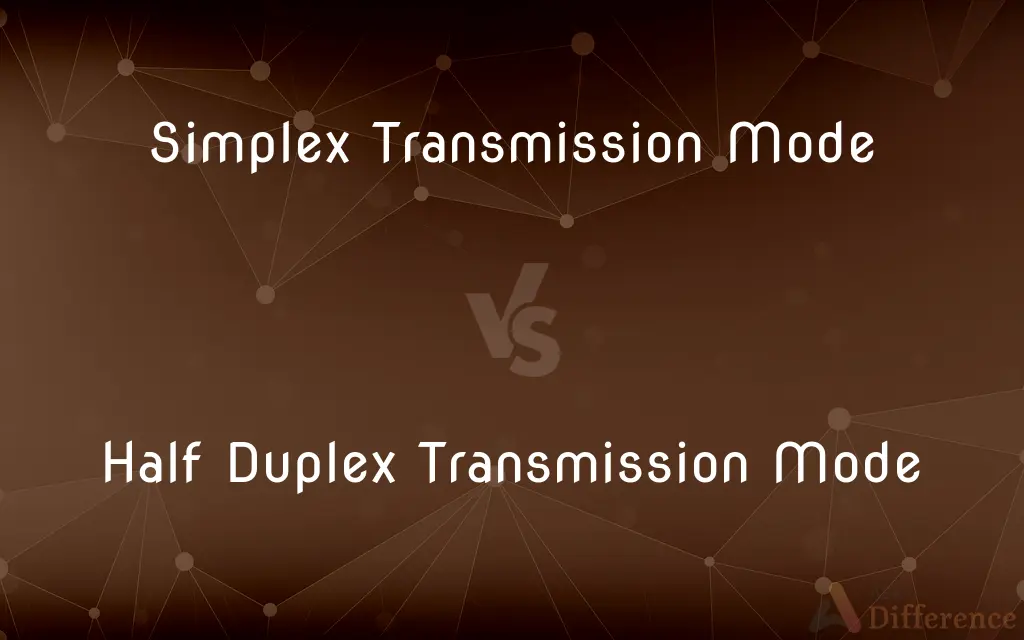Simplex Transmission Mode vs. Half Duplex Transmission Mode — What's the Difference?
By Tayyaba Rehman & Urooj Arif — Published on January 30, 2024
Simplex transmission mode allows communication in only one direction, while Half Duplex allows bidirectional communication, but not simultaneously.

Difference Between Simplex Transmission Mode and Half Duplex Transmission Mode
Table of Contents
ADVERTISEMENT
Key Differences
Simplex Transmission Mode is a communication method where signals are transmitted in only one direction, from the sender to the receiver, with no return path. Conversely, Half Duplex Transmission Mode allows for two-way communication, but not simultaneously; a device can either send or receive at any given time, but not both.
In Simplex Transmission Mode, the communication channel's capacity is utilized only in one direction, making it ideal for applications like broadcasting where feedback is not required. Half Duplex Transmission Mode, however, uses the channel capacity more efficiently by alternating between sending and receiving, useful in two-way communication systems like walkie-talkies.
The main advantage of Simplex Transmission Mode is its simplicity and reliability, as there is no need to manage the direction of traffic, which is ideal for consistent data streaming. In contrast, Half Duplex Transmission Mode offers more flexibility by allowing back-and-forth communication, but requires mechanisms to prevent collision and ensure orderly communication.
Applications of Simplex Transmission Mode are found in environments where information flow is one-sided, such as television broadcasts or public address systems. Half Duplex Transmission Mode is commonly used in scenarios where interactive communication is needed but full duplex systems are not feasible or necessary, like in certain security systems or older computer networks.
Simplex Transmission Mode is limited by its inability to accommodate interactive communication, which is a crucial component in many modern communication systems. Half Duplex Transmission Mode, while offering interactive capabilities, is limited by the fact that it cannot send and receive information simultaneously, potentially causing delays in communication.
ADVERTISEMENT
Comparison Chart
Direction of Communication
One-way only
Two-way, but not simultaneously
Use Case
Broadcasting, alerts
Walkie-talkies, certain network communications
Traffic Management
Not required
Required to avoid collisions
Interactive Capability
No
Yes, but limited
Efficiency in Channel Usage
Efficient for one-way communication
More efficient by alternating send/receive
Compare with Definitions
Simplex Transmission Mode
Communication in a single direction without feedback.
Radio broadcasts use Simplex Transmission Mode to transmit signals.
Half Duplex Transmission Mode
Alternating transmission and reception of signals.
Old network routers often used Half Duplex Transmission Mode.
Simplex Transmission Mode
One-directional signal transmission without return path.
Television signals are an example of Simplex Transmission Mode.
Half Duplex Transmission Mode
Communication where devices take turns to transmit and receive.
Some wireless communication systems use Half Duplex Transmission Mode for controlled data exchange.
Simplex Transmission Mode
Transmission where the receiver cannot send data back.
Digital billboards use Simplex Transmission Mode to display advertisements.
Half Duplex Transmission Mode
Bidirectional communication with time-sharing.
Security intercoms use Half Duplex Transmission Mode for speaking and then listening.
Simplex Transmission Mode
Unidirectional communication from a source to a destination.
Public address systems in stadiums use Simplex Transmission Mode.
Half Duplex Transmission Mode
Two-way communication but not at the same time.
Walkie-talkies operate on Half Duplex Transmission Mode for alternate talking and listening.
Simplex Transmission Mode
A method where data flows from a sender to a receiver only.
Emergency sirens operate in Simplex Transmission Mode, sending alerts one way.
Half Duplex Transmission Mode
A transmission method allowing both sending and receiving, but separately.
CB radios typically use Half Duplex Transmission Mode for back-and-forth conversation.
Common Curiosities
Can Half Duplex Transmission Mode send and receive simultaneously?
No, it alternates between sending and receiving.
Where is Simplex Transmission Mode commonly used?
It's used in broadcasting, alerts, and one-way communication systems.
What are typical uses of Half Duplex Transmission Mode?
Walkie-talkies and some older network communication systems.
Does Half Duplex Transmission Mode require traffic management?
Yes, to avoid collisions and manage alternating communication.
What is Half Duplex Transmission Mode?
Half Duplex allows two-way communication but not at the same time.
Can Simplex Transmission Mode support interactive communication?
No, it only supports one-way communication.
Is Simplex Transmission Mode efficient for broadcasting?
Yes, it's efficient for one-way transmission like broadcasting.
How does Half Duplex differ from Full Duplex?
Half Duplex alternates between sending and receiving, while Full Duplex does both simultaneously.
What is Simplex Transmission Mode?
Simplex Transmission Mode is a communication method where signals travel in only one direction.
How do Half Duplex devices avoid communication collisions?
Through control mechanisms that manage when a device can send or receive.
Is there feedback capability in Simplex Transmission Mode?
No, there is no mechanism for feedback.
Is Simplex Transmission Mode suitable for interactive applications?
No, it's not suitable for applications requiring two-way communication.
What is a limitation of Simplex Transmission Mode?
It cannot accommodate back-and-forth communication.
Can Half Duplex Transmission Mode be used for internet networking?
Yes, but it's less common now with the prevalence of Full Duplex systems.
Does Simplex Transmission Mode require complex hardware?
No, it generally requires simpler hardware compared to duplex systems.
Share Your Discovery

Previous Comparison
Male Blue Crabs vs. Female Blue Crabs
Next Comparison
Final in Java vs. Finalize in JavaAuthor Spotlight
Written by
Tayyaba RehmanTayyaba Rehman is a distinguished writer, currently serving as a primary contributor to askdifference.com. As a researcher in semantics and etymology, Tayyaba's passion for the complexity of languages and their distinctions has found a perfect home on the platform. Tayyaba delves into the intricacies of language, distinguishing between commonly confused words and phrases, thereby providing clarity for readers worldwide.
Co-written by
Urooj ArifUrooj is a skilled content writer at Ask Difference, known for her exceptional ability to simplify complex topics into engaging and informative content. With a passion for research and a flair for clear, concise writing, she consistently delivers articles that resonate with our diverse audience.












































